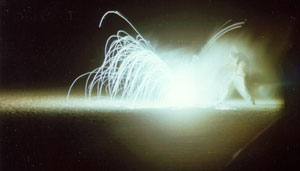Fire retardant agent proves successful for students, professor
Ten years of research and experimentation have paid off for Dr. George Uhlig, chemistry professor for the College of Eastern Utah and his team of student researchers when the
Federal Aviation Authority approved their revolutionary fi re retardant agent FEM-12SC in September 2007, for production and distribution world wide.
With the rising use of magnesium in the production of automobiles and
air craft, the recognition of the chemical by the FAA couldn’t have came at
a better time according to Uhlig.
“When magnesium catches on fire, the use of water will cause the fire to

This archived article was written by: Kris Kohler
Ten years of research and experimentation have paid off for Dr. George Uhlig, chemistry professor for the College of Eastern Utah and his team of student researchers when the
Federal Aviation Authority approved their revolutionary fi re retardant agent FEM-12SC in September 2007, for production and distribution world wide.
With the rising use of magnesium in the production of automobiles and
air craft, the recognition of the chemical by the FAA couldn’t have came at
a better time according to Uhlig.
“When magnesium catches on fire, the use of water will cause the fire to
ignite even further, literally creating an explosion,” Uhlig said. “When
using our substance on the same fire, there is no explosion, no sparks and
no hassle, just a better, safer method of extinguishing.”
According to Uhlig, the substance will put out a magnesium fi re in under
a minute and will also work on diesel and gasoline fires as well.
“When tested on fi ve tractor trailer tires that were burning out of control,
our substance extinguished the blaze in under 30 seconds to the point that
you could walk up and touch the tires with your bare hands,” said Uhlig. “A
dry chemical extinguisher will put out the blaze but it wont keep it out,
our stuff will not only put out the fire but it will prevent it from re-igniting.” FEM-12SC
is environmentally safe and non toxic to humans or animals according to Uhlig
and is made almost entirely off different types of fertilizers.
The substance can also be used to prevent certain types of coal mine disasters by coating the coal in the gob, completely preventing it to burn, thus reducing the risk of
mine fi res in locations that are inaccessible to miners due to the lack of roof support.
“One of our best tests concerning coal fires was done at the McLean
Mine. The only problem with stopping a mine fi re is fi nding the fi re
front,” said Uhlig. “We found one of the several fronts and after pumping
in our agent we were able to stop the fire from advancing but due to one
of the many other fronts the fi re was able to spread around the treated area
and continue burning.”
According to Dr. Uhlig there is research currently underway that will
possibly reduce the cost of the formula making it easier for coal mines to
make the change from dry chemical extinguishers to FEM-12SC. The
extinguishers will be the same, only the content will change.
“There have been numerous disasters throughout history that may never
have happened if this formulation had been known,” said Uhlig. “I believe
that the Willow Creek disaster is just one of the many.”
The 24 Hours of Le Mans Disaster on June 11, 1955 is another example,
with Pierre Levegh behind the wheel of the #20 Mercedes-Benz 300 SLR
run by Daimler-Benz.
There was a devastating wreck and as the remains of the 300 SLR slowed its somersault, the fuel tank, situated behind Levegh’s seat, ruptured. The ensuing fuel fi re raised the
temperature of the remaining electron bodywork past its flash-point, which due to its high magnesium content was already very low. Magnesium’s properties mean that
a combustion in oxygen is possible at relatively low temperatures,
allowing the alloy to burst into white hot fl ames, sending searing embers onto the track and into the crowd.
Rescue workers attempting to put out the burning wreckage were unsuccessful as they
unknowingly used water on the magnesium fi re, which only intensifi ed the inferno.
As a result, the car burned for several hours. In total, 82 spectators were killed either
by flying parts or from the fire, according to wikipedia.org.
“We have indications that several large airports will be ordering our product to replace all of their dry chemical for plane crashes,” said Uhlig. “We are also working toward
marketing the agent to the automobile industry now that most manufacturers are using more and more magnesium and titanium in the construction of their vehicles.”
The ten years of research that has been done to perfect FEM-12SC, has
been done completely by CEU students under the guidance of Dr. Uhlig.
FEM-12SC is patented and there are several other pending patents in the
names of some of the students that have contributed to the project. According
to Uhlig, every student that contributed to the project will be compensated for
their hard work when Thermic Labs Inc. goes public.




